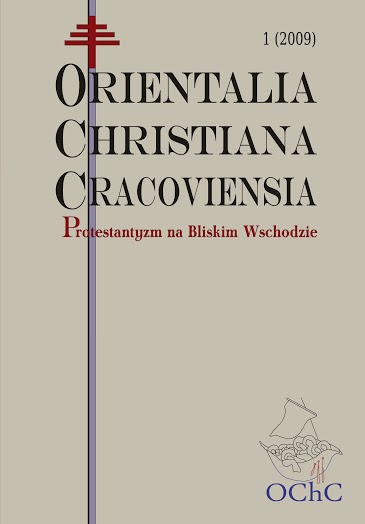Od Antychrysta do sprzymierzeńca Goga – zmieniająca się rola islamu w interpretacjach premillenarystów
DOI:
https://doi.org/10.15633/ochc.1006Słowa kluczowe:
Premilenaryści, islamAbstrakt
It was after the September 11, 2001 that Islam began to play a role in American Protestant visions of Armageddon. However, the Islam issue appeared in Protestant prophetic theology much earlier. Premilleniarians’ interpretations of the Holy Bible frequently concentrate on Islam and the Muslim world as an important factor of Armageddon.
In the United States the Protestant concept of Armageddon was based in the 19ᵗʰ century in the theological stream of dispensationalism. According to this concept the identity of Antichrist was changed several times but it was the Islam world which influenced this identity most.
Theories about Islam and Armageddon have been arising since the 7ᵗʰ century. Especially, during the Peasant Crusade the negative attitudes towards the Muslims were natural. Christian authorities started to identify Mahomet with Antichrist, the synonym of plagues and apocalyptic disaster. In the 11ᵗʰ century, for instance, it was the result of growing position of the Muslim world and the decline of Christianity and its culture in the Near East.
Martin Luther in his Bile in 1534 tried to compare Turkey to GOG (from the Book of Ezekiel). This vision of Martin Luther was present till the 19ᵗʰ century, till the collapse of Ottoman Empire. Then it was Russia (communism) and their allies in the Near East: Egypt, Iran and Algeria which took the place of GOG. After 1979 and the revolution in Iran American Protestant thinkers focused on ayatollahs as precursors of the Antichrist. In his 1994 book Hal Lindsey tried to convince the readers that the Islamic Ayatollah constituted the greatest threat to Christianity. The origins of the conflict between Islam and Christianity are partly embedded in the Holy Bible (Book of Ezekiel, Book of Daniel, Book of Revelation). However, new modern prophetic visions, which describe the representative of Islam and a full complexity of religious issues are very often an oversimplification.
Bibliografia
Boyer P., When Time Shall Be no More, Cambridge 1992.
Cohn N., The Pursuit of the Millennium, New York 1970.
Frykholm A. J., Rapture Culture, New York 2007.
Fuller R., Naming the Antichrist, New York 1995.
Guyatt N., Have a Nice Doomsday, New York 2007.
Hagee J., Jerusalem Countdown, Lake Mary 2006.
Hitchcock M., Ice T., The Truth Behind Left Behind, Oregon 2004.
Kidd T. S., Islam in American Protestant Thought, „Books & Culture” 12 (2006) nr 5.
LaHaye T., Jenkins J. B. , Are We Livining in the End Times?, Wheaton, Illinois 1999.
Lindsey H., The Late Great Planet Earth, New York 1981.
Ryrie C., Dispensationalism, Chicago 2007.
Standaert M., Skipping Towards Armageddon, Brooklyn, New York 2006.
Shuck G. W., Marks of The Beast, New York 2005.
Walvoord J. F., Armageddon, Oil and the Middle East Crisis, Grand Rapids 1990.
Williams M., This world is not my home. The origins and development of dispensationalism, Fearn 2003.
Pobrania
Opublikowane
Numer
Dział
Licencja
Twórca oświadcza, że przysługują mu prawa autorskie do utworu i że nie są ograniczone w zakresie objętym niniejszym oświadczeniem oraz że utwór jest dziełem oryginalnym i nie narusza praw autorskich innych osób.
Twórca zezwala Uniwersytetowi Papieskiemu Jana Pawła II w Krakowie na nieodpłatne, niewyłączne i nieograniczone w czasie korzystanie z utworu, to jest:
- utrwalanie i zwielokrotnianie: wytwarzanie egzemplarzy utworu techniką drukarską, reprograficzną, zapisu magnetycznego oraz techniką cyfrową;
- obrotu oryginałem albo egzemplarzami, na których utwór utrwalono (wprowadzanie do obrotu, użyczenie lub najem oryginału albo egzemplarzy, publiczne wystawienie, wyświetlenie, a także publiczne udostępnianie utworu w taki sposób, aby każdy mógł mieć do niego dostęp w miejscu i w czasie przez siebie wybranym);
- włączenie utworu w skład utworu zbiorowego;
- udzielanie przez Uniwersytet Papieski Jana Pawła II w Krakowie sublicencji Creative Commons Uznanie autorstwa-Użycie niekomercyjne-Bez utworów zależnych 3.0 Polska
Uniwersytet Papieski Jana Pawła II w Krakowie udostępnia utwór na Platformie Czasopism należącej do uczelni, na licencji Creative Commons Uznanie autorstwa-Użycie niekomercyjne-Bez utworów zależnych 3.0 Polska. Tym samym uprawnia wszystkich zainteresowanych do korzystania z utworu pod następującymi warunkami:
- zostanie podany autor i tytuł utworu,
- zostanie podane miejsce publikacji (tytuł czasopisma i adres internetowy do oryginalnie opublikowanego utworu),
- utwór będzie dystrybuowany w sposób niekomercyjny,
- nie będą tworzone utwory zależne.

